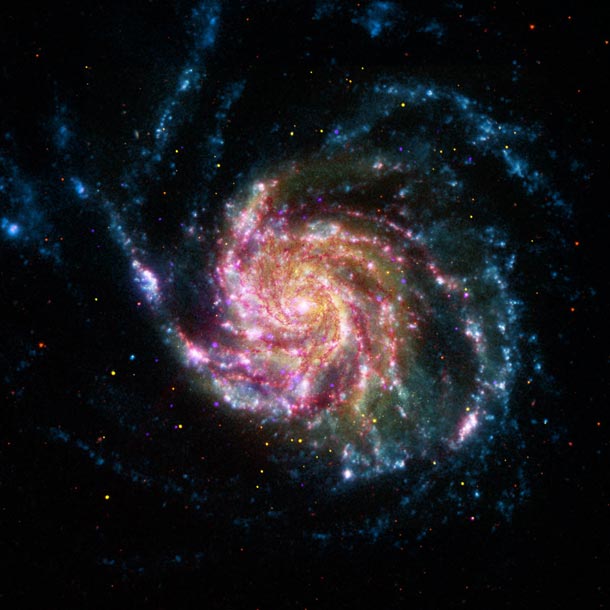Create a free profile to get unlimited access to exclusive videos, sweepstakes, and more!
Rainbow Pinwheel galaxy

I have no shame in admitting I love face-on spiral galaxies. Scientifically, of course, they're fascinating; spread out in front of us are all the inner workings of a galaxy. It's like having an X-ray of human body in front of you, making it easier to understand anatomy.
But their beauty... well. The scope and grandeur of a face-on spiral is unparalleled, I think, in astronomy, or perhaps any field of science. But don't take my word on it. See for yourself.
[Click to galactinate, or get a 1900 x 1200 desktop image.]
This is the wonderful nearby spiral M101, and is a composite of no fewer than four orbiting observatories! It has images from Hubble, Spitzer, Chandra, and GALEX. These represent (in order) observations in visible light (shown as yellow in the picture), infrared (red), X-ray (purple) and ultraviolet (blue).
Each shows a different aspect of the galaxy. Visible light shows stars and gas, infrared indicates warm dust, X-ray show hot gas and energetic objects like supernovae and black holes, and ultraviolet is where young stars glow and light the gas around them. Each observation is incredibly useful to a scientist, but combining them together makes them even more powerful.
The things to look for are where colors overlap, and where they don't overlap. For example, in the outer arms you can see dust and gas and young stars all together, showing where stars are born. In the inner regions of the galaxy the infrared and visible images are next to each other, parallel spirals. Dust blocks visible light, so where there's lots of dust there's little light we can see, and vice-versa.
You have to be careful interpreting images like this, though. The outer arms, for example, are blue. You might think this means they're only giving off ultraviolet light. But you have to account for the different telescopes' field of view, exposure times, and more. Each of those affects what you see no matter what the galaxy itself may be doing. Images like the one above are useful, even important, but it's also important to remember their scientific limitations.
But artistically? That's a different matter. All together.
Image credit: X-ray: NASA/CXC/SAO; IR & UV: NASA/JPL-Caltech; Optical: NASA/STScI
Related Posts:
- Hubble delivers again: M101
- New pic: SN2011fe in M101
- The heat of the Pinwheel
- Desktop Project Part 9: Again I see IC 342



























